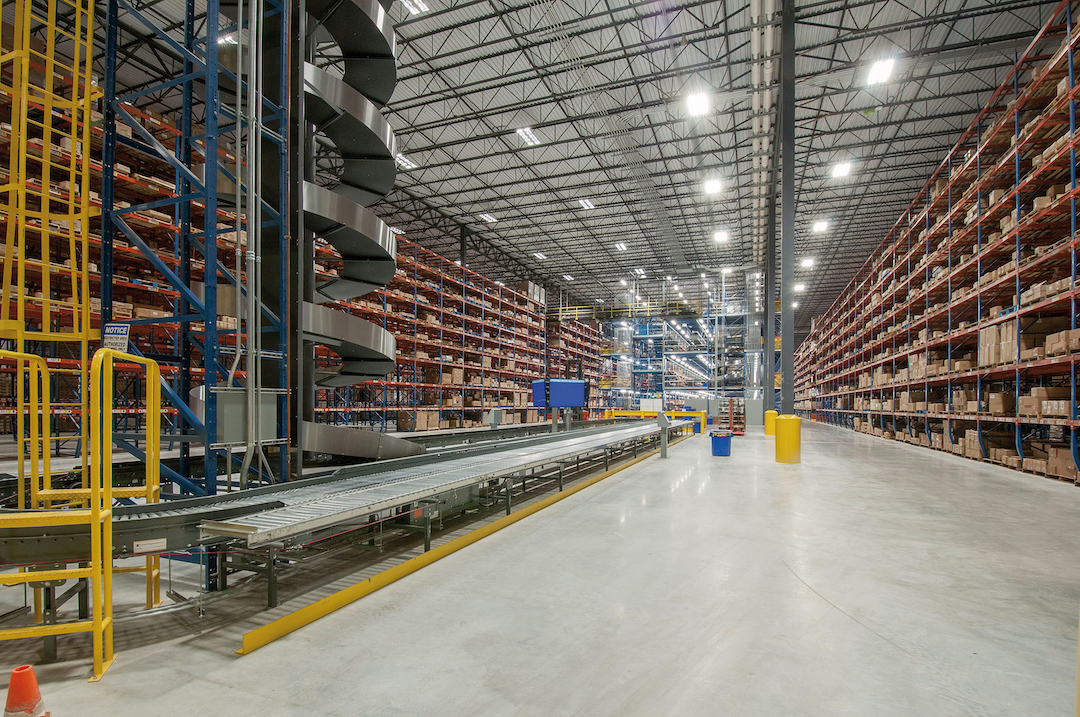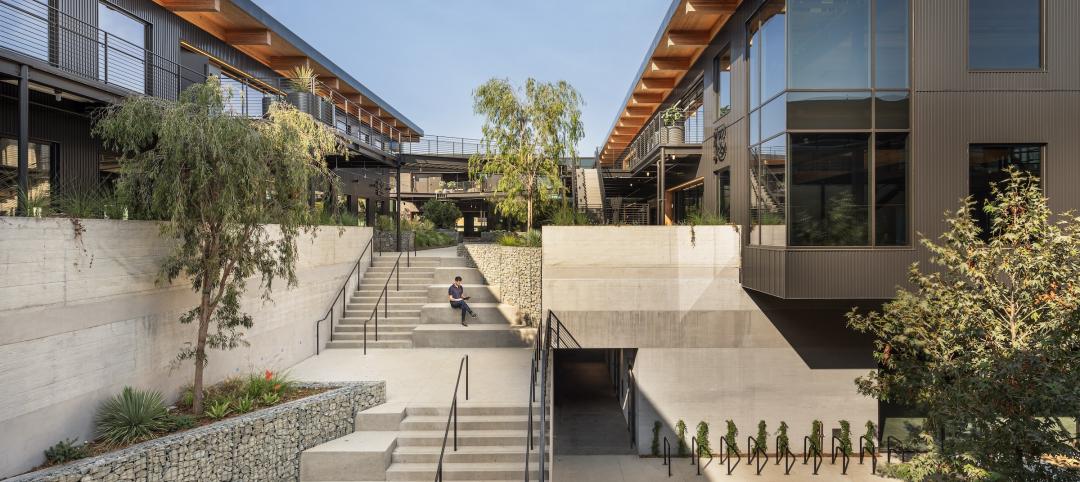The demand created by the unstoppable growth of ecommerce continues to have a major impact on the industrial building sector’s design and construction of factories, warehouses, distribution centers, and fulfillment centers.
Walmart Mexico is in the midst of a five-year program to build 15 distribution centers across that country. SSOE Group has engaged in the design and construction management of three of these so far: a 376,000-sf building in Chihuahua, a 645,000-sf distribution center in Tabasco, and a 400,000-sf facility in Chalco, according to Erick Kuri, SSOE’s Mexico Division Manager.
Stantec is experiencing greater demand for distribution centers (DCs) in all geographies, says George Halkias, a Senior Principal with the firm. He says the location of warehouse, distribution, and fulfillment centers is often determined by how quickly that building can be operational.
Related content: Top 70 Industrial Sector Architecture Firms
Related content: Top 85 Industrial Sector Engineering Firms
Related content: Top 95 Industrial Sector Contractors Firms
Michael Schmidt, Leo A Daly’s Market Sector Leader for Food, Distribution, and Manufacturing, sees clients shifting from large, remote distribution facilities to fulfillment centers closer to metros. One retail client, Target, commissioned his firm to transform one quarter of the square footage in five of Target’s million-sf DCs to accommodate fulfillment functions.
Ware Malcomb, which designs about 70 million sf of industrial space annually, is designing fulfillment centers that range from 40,000 sf to more than a million sf. Jim Terry, a Principal with the firm, notes that ceiling heights in some specialized ecommerce centers reach as high as 100 feet. Developers are considering cubic volume (abetted by technology) to accommodate more goods, and are asking for buildings with up to 40 feet of clear ceiling height.
Eric Buer, Burns & McDonnell’s Real Estate Development Director, says there’s a “huge need” for various types of warehousing and logistics capacity in response to the online sales boom. But at the current pace of development, only about half of the needed space over the next five years will be available.
The industry is definitely homing in on strategies to enhance and improve last-touch distribution capabilities. “The costs associated with multiple deliveries are the single largest target margin left in this cycle,” says Brian Chatham, a Project Manager with Burns & McDonnell. Chatham anticipates that freight consolidation by seller or delivery point will be an ongoing effort among operators.
Automating industrial facility operations
Automated storage and retrieval systems and robotics in general are becoming more common in industrial facilities, too, so Stantec has been working with clients to determine automation’s real impact on their ROI. Stantec uses such tools as discrete-event simulation and mathematical optimization to model, test, improve, and evaluate systems performance in a virtual environment against stated project objectives.
Kuri of SSOE adds that automation integration is driving mechanical and electrical support systems to accommodate fewer employees, “or essentially be able to go dark with lighting systems only for maintenance.”
Tech is pervasive in this sector. Todd Schell, Senior Vice President–Industrial Sector for Ryan Companies, spots a “renaissance” in concrete technology that, for DCs, helps to minimize the need for sawcut or other joints that are hard on equipment. Prefabrication is also a growing trend, which Schell says is being utilized mostly for MEP construction.
Ryan Companies uses BIM and VDC frequently during the design phase of industrial projects to eliminate conflicts. Clayco, which started or completed 41.2 million sf of industrial projects in 2018, designs all projects for this sector in 3D and in ways that the facility can be built in modularized sections offsite, says Anthony J. Johnson, Clayco’s Executive Vice President and Industrial Business Unit Leader.
As industrial buildings move nearer to urban areas, their designs are taking into account the surrounding aesthetic. “Our design approach is to look at warehouses as workplaces worthy of design excellence as a Class A office building,” says Schmidt of Leo A Daly.
The primary goal of any big change in this sector is, inevitably, faster delivery. “That requires finding land closer to customers, efficiency in scaling, and shortening delivery timeframes,” observes Clayco’s Johnson.
Buer says his firm is working on design ideas “for same-day, same-hour delivery options.” Like other AEC firms in this sector, Burns & McDonnell is keeping a close eye on the demand for and efficacy of multistory warehouse and distribution centers that last year started popping up in a few U.S. cities.
“The exciting new trend is for freestanding, multistory warehouses within metro areas,” says Borys Hayda, Partner and Managing Principal with DeSimone Consulting Engineers, which is designing five such projects to be located in the New York boroughs of Queens, Brooklyn, and The Bronx.
Ware Malcomb is working on five multistory distribution projects that are in various stages of development. The firm has master-planned over 50 sites to accommodate these facilities in major North American markets, says Michael Bennett, a Principal with the firm.
MORE FROM BD+C'S 2019 GIANTS 300 REPORT
Related Stories
Sustainability | Sep 18, 2024
3 living buildings made by a living practice
Prompting humans to reexamine our relationship to the environment, architecture creates the opportunity for us to physically experience ideas of beauty, performance, and structure through the distinct lens of place.
3D Printing | Sep 17, 2024
Alquist 3D and Walmart complete one of the nation’s largest free-standing, 3D-printed commercial structures
Walmart has completed one of the largest free-standing, 3D-printed commercial structures in the US. Alquist 3D printed the almost 8,000-sf, 20-foot-high addition to a Walmart store in Athens, Tenn. The expansion, which will be used for online pickup and delivery, is the first time Walmart has applied 3D printing technology at this scale.
Retail Centers | Sep 17, 2024
Thinking outside the big box (store)
For over a decade now, the talk of the mall industry has been largely focused on what developers can do to fill the voids left by a steady number of big box store closures. But what do you do when big box tenants stay put?
Government Buildings | Sep 17, 2024
OSHA’s proposed heat standard published in Federal Register
The Occupational Safety and Health Administration (OSHA) has published a proposed standard addressing heat illness in outdoor and indoor settings in the Federal Register. The proposed rule would require employers to evaluate workplaces and implement controls to mitigate exposure to heat through engineering and administrative controls, training, effective communication, and other measures.
Codes and Standards | Sep 17, 2024
New California building code encourages, but does not mandate heat pumps
New California homes are more likely to have all-electric appliances starting in 2026 after the state’s energy regulators approved new state building standards. The new building code will encourage installation of heat pumps without actually banning gas heating.
Mass Timber | Sep 17, 2024
Marina del Rey mixed-use development is L.A.’s largest mass timber project
An office-retail project in Marina del Rey is Los Angeles’ largest mass timber project to date. Encompassing about 3 acres, the 42XX campus consists of three low-rise buildings that seamlessly connect with exterior walkways and stairways. The development provides 151,000 sf of office space and 1,500 sf of retail space.
Education Facilities | Sep 16, 2024
Hot classrooms, playgrounds spur K-12 school districts to go beyond AC for cooling
With hotter weather occurring during the school year, school districts are turning to cooling strategies to complement air conditioning. Reflective playgrounds and roads, cool roofs and window films, shade structures and conversion of asphalt surfaces to a natural state are all being tried in various regions of the country.
Office Buildings | Sep 16, 2024
Maximizing office square footage through ‘agile planning’
Lauren Elliott, RID, NCIDQ, Director of Interior Design, Design Collaborative, shares tips for a designing with a popular and flexible workspace model: Agile planning.
3D Printing | Sep 13, 2024
Swiss researchers develop robotic additive manufacturing method that uses earth-based materials—and not cement
Researchers at ETH Zurich, a university in Switzerland, have developed a new robotic additive manufacturing method to help make the construction industry more sustainable. Unlike concrete 3D printing, the process does not require cement.
Libraries | Sep 12, 2024
How space supports programming changes at university libraries
GBBN Associate Sarah Kusuma Rubritz, AIA, uses the University of Pittsburgh's Hillman Library to showcase how libraries are transforming to support students’ needs.

















